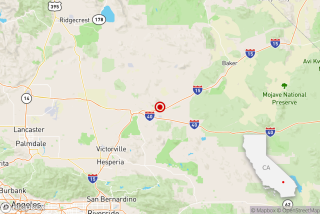6.3 Quake Jolts Border Area Near Tahoe : Temblor: There is some minor damage, but no injuries are reported in lightly populated region.
- Share via
A strong earthquake Monday in a lightly populated area along the California-Nevada border 20 miles southeast of Lake Tahoe broke dishes, damaged chimneys and shook rocks onto highways, but caused no injuries.
The National Earthquake Information Center in Golden, Colo., put the preliminary magnitude at 6.3 and placed its epicenter two miles inside Nevada, about 12 miles south of Gardnerville. Some other seismological laboratories set the quake’s magnitude at a weaker 6.0.
Damage was reported in the Nevada communities of Gardnerville and Minden and in California at the Alpine County seat of Markleeville, where debris fell off the courthouse and building inspectors were summoned for a safety evaluation.
An aftershock measuring magnitude 5.3 was felt in the region late Monday afternoon.
The 5:23 a.m. earthquake was felt distinctly as far away as Sacramento and Reno. California State Geologist James Davis said the quake was strong enough in Sacramento to be felt indoors by practically everyone and outdoors by most and caused “slight excitement.”
Near the epicenter, some people said they were frightened.
“It was real scary,” said Carolyn Davis, manager of the Riverview Mobile Home Park, six miles south of Gardnerville. “It seemed to last a long time and we had quite a few things break. The road in front of my trailer is crumbled and a bookcase turned over.”
In Minden, Bill Henderson, director of sales at the Carson Valley Inn, said a television set fell off its perch, and “all of our guests came down and ate an early breakfast. . . . There were a lot of comments about how effective our wake-up system was.”
This was the second strong earthquake felt through much of Northern California in the last two weeks, but both were centered well away from big cities. The earlier quake, now assigned a revised magnitude of 7.0 by the U.S. Geological Survey, occurred Sept. 1 and was centered in the ocean 90 miles southwest of Eureka.
Scientists noted that the locale of Monday’s earthquake was the site of several other quakes in the magnitude 6 range in the 19th Century. Two such quakes occurred within 10 hours of each other on Dec. 26 and 27, 1869, and other strong quakes occurred in 1860 and 1887. A magnitude 5.2 quake was felt in the area in 1978.
The University of Nevada quickly sent a team of scientists to the vicinity of the epicenter, but there was no immediate discovery of any surface rupture.
A university seismologist, John Anderson, said the quake occurred about six miles beneath the surface and lasted only about five seconds. He and Davis said it was possible that it was associated with strands of the Genoa Fault, a horizontal, strike-slip fault.
Alpine County, the closest part of California to the epicenter, is the state’s smallest in population, with fewer than 1,300 residents.
“In surveying the town of Markleeville, it appears that most of the damage was to shelf stock in the local businesses,” said a statement from the Alpine County sheriff’s office.
“Bricks fell from the chimney of one house in town and some damage has been detected at the courthouse and the county administration building. At the courthouse, grout fell out of some of the exterior windows. At the administration building, some ceiling tiles fell to the floor and there was damage to some heating ducts.”
Before the 5.3-magnitude aftershock, David Hill of the Geological Survey’s Menlo Park regional office had said that there was about a 50-50 chance of an aftershock stronger than 5.0.
More to Read
Sign up for Essential California
The most important California stories and recommendations in your inbox every morning.
You may occasionally receive promotional content from the Los Angeles Times.













